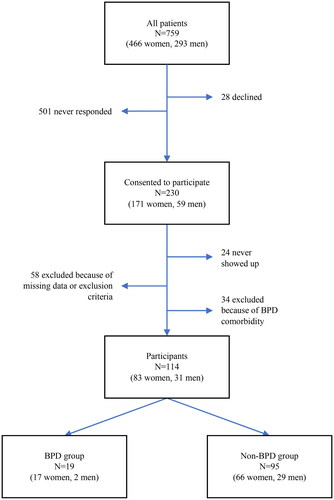Figures & data
Figure 1. Flowchart of the recruitment process, starting with all psychiatric patients diagnosed with either borderline personality disorder (BPD), bipolar disorder (BD), and/or attention-deficit/hyperactivity disorder (ADHD) between May 2005 and October 2010, at a specific outpatient clinic.

Table 1. Descriptive data for the BPD group and the non-BPD group (BD/ADHD) in a young psychiatric sample.
Table 2. Comparison of median TCI scores for the BPD group and the non-BPD group in a young psychiatric sample.
Table 3. Odds ratios for the four trauma categories of the ETI-SR-SF predicting BPD in a sample of young psychiatric patients with BPD or non-BPD, the latter constituted by BD and/or ADHD.
Table 4. Results of the logistic regression of temperament and trauma on a BPD diagnosis.
Data availability statement
The data that support the findings of this study are available on reasonable request from the corresponding author [IK]. The data are not publicly available due to them containing information that could compromise research participant consent.
No funding sources.
